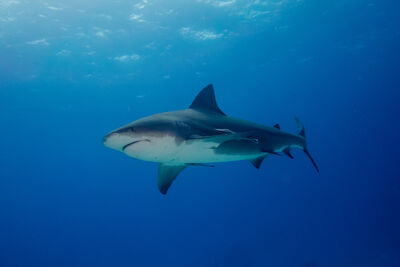Brutish bull sharks get a bad rep. Despite joining great white and tiger sharks in the 'Big Three' for shark attacks, these formidable fish face far more danger from us than we do from them. As apex predators, bull sharks are pivotal to keeping marine ecosystems in balance. However, like many other shark species, they are classified as 'Vulnerable' by the IUCN, with their main threats arising from human activity. The key to conserving these misunderstood marine marvels is understanding them. From their unique biological quirks to their maternal instincts, discover ten fascinating bull shark facts.

1, The ‘Bull’ in Bull Shark
Stoutly bull sharks get their name from their short, blunt snout, stocky appearance and bullish nature. These compact powerhouses reach an average length of three-and-a-half metres and can weigh up to a whopping 500 pounds. As one of the most dangerous shark species of the sea, these aggressive predators will often head-butt their prey before attacking.
2. The Tenacious Wanderers
Bull sharks are renowned for their incredible migratory patterns. They aren't bothered by freshwater, meaning they can navigate vast distances across oceans, rivers and tributaries. Unlike other shark species, these versatile wanderers can venture far inland up freshwater systems for feeding or breeding purposes. Take Brisbane River in Queensland, Australia, which regularly hosts as many as 20 bull sharks in its waters.

3. The Ultimate Opportunists
Bull sharks aren't fussy eaters. As opportunistic predators, bull sharks will chow down on anything they come across, with a wide-ranging menu that includes fish, rays, turtles, crustaceans, dolphins, and even other sharks - including bull sharks. Their powerful jaws and serrated teeth make them formidable hunters, capable of taking down prey larger than themselves.
4. Human Encounters
Bull sharks are renowned for being the most dangerous shark species in the world, and, alongside tiger sharks and great whites, are the most likely to attack humans. Bull sharks are aggressive and highly territorial, often staking their claim in areas where resources are plentiful, like tropical coastlines. Unfortunately, humans also tend to flock to these areas, and while we aren't on their menu, bull sharks are known for sometimes attacking people out of curiosity.

5. A Formidable Bite
The bite force of a bull shark is nothing short of impressive. With bite strength estimated to be around 1,300 pounds per square inch (psi), they have one of the most powerful bites of any fish, out-biting both great white sharks and great hammerheads.
6. They Thrive in Both Marine and Freshwater Habitats
Unlike most shark species, bull sharks can adapt and thrive in both saltwater and freshwater. Bull sharks are capable of osmoregulation, whereby they can regulate the balance of salt and water in their bodies. When bull sharks venture into freshwater rivers or lakes, they actively retain the necessary salts in their bodies to prevent dehydration.

7. Unique Reproductive Strategy
Unlike most shark species that lay eggs, bull sharks follow an ovoviviparous reproductive strategy. The females keep fertilized eggs inside their bodies until they hatch, giving birth to live young. This adaptation enables bull sharks to provide immediate protection and increases the chances of offspring survival.
8. Maternal Instincts
After a gestation period of around 12 months, female bull sharks give birth to live young in estuaries or shallow coastal waters. While female bull sharks do not rear their young, these nurseries provide protection from larger predators, ensuring the survival of the next generation of bull sharks. Once bull sharks mature, they tend to move to saltwater habitats.

9. Where to Dive with Bull Sharks
Despite their man-eating reputation, bull sharks pose minimal risk to humans. While these stocky predators can be found in warm, coastal waters around the world, there are several stand-out spots where you can safely dive with bull sharks. One of the most famous dives - The Arena - takes place in Beqa Lagoon, Fiji. Hailed as the best shark dive in the world, divers can see bull sharks alongside tawny nurse, sicklefin lemon, silvertip and tiger sharks. Other popular spots include Playa del Carmen in the Yucatan Peninsula and Cabo Pulmo in Baja California, Mexico.
10. Conservation Concerns
Unfortunately, bull sharks face many threats due to human activities and are currently listed as 'Vulnerable' on the IUCN Red List of Threatened Species. While there have been 121 bull shark attacks in history, an estimated 100 million sharks are killed every year by humans. The main threat to bull sharks is humans, with overfishing, habitat destruction and water pollution significantly affecting their populations.
If these bull shark facts have inspired you to dive with these misunderstood marine creatures, get in touch with our diving experts to learn the best places and times to dive with bull sharks.












